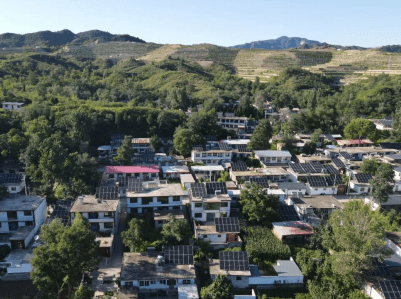The below content is the complete 101 guide to balcony solar panels, written for anyone who knows absolutely nothing about solar energy.
- About Photovoltaics and Power Station Types
What are Photovoltaics?
Photovoltaics (PV) is a new form of power generation that uses the photovoltaic effect in semiconductor materials to directly convert solar radiation into electricity. Simply put, photovoltaics is the process of turning sunlight into usable electricity.
- Power Station Classifications
PV power stations are classified as either grid-tied or off-grid, depending on their relationship with the utility grid.
As the names suggest, a grid-tied power station is connected to the utility grid. An off-grid power station is completely detached from the grid and operates as a self-contained system.
PV power stations are also classified as centralized or distributed, based on their installation location.
Distributed power stations are further divided into residential systems (installed on homes), and commercial and industrial systems (installed on factories, shopping malls, etc.).
Further classifications can be made based on different installation techniques, grid-connection methods, and so on.
For our purposes, you just need to know that a balcony PV system is essentially a residential grid-tied PV power station. So, if the grid goes down, your balcony PV system will stop working too!
- Introduction to Balcony PV
Background
Balcony PV, also known as DIY PV in other countries, is a photovoltaic system that ordinary people can easily install on their own balconies. It is very popular abroad, especially in Europe. Currently, the domestic residential market is tough to break into, and grid capacity is becoming scarce. These conditions have created an opportunity for balcony PV to enter thousands of households.
- Components of a Balcony PV System
The core components are:
- One microinverter
- A few (1-4) photovoltaic panels
- Mounting brackets to secure the panels
- Cables connecting the microinverter and panels
The following sections will provide detailed explanations of these components.
- Key Requirement for Installing Balcony PV
Due to the limitations of currently mass-produced products, the key requirement for installing a balcony PV system is that you must be able to use up all the electricity it generates during the day. In plain terms, the power your balcony PV system produces must be fully consumed on the same day.
In the near future (estimated January 2025), balcony PV microinverters that can be paired with energy storage will be mass-produced. This will make it possible to store electricity for use at night or at a later time.
- How Balcony PV Works
You just need to know this: as long as your balcony PV system is generating electricity, your home will automatically use the power from the PV system first. The specific installation process will be described below.
III. Balcony PV — Microinverters
What are Microinverters?
An inverter, also known as a converter, is a device that converts the direct current (DC) from solar panels into the alternating current (AC) that we use in our homes. Common types of inverters in the PV industry include string inverters, microinverters, central inverters, and off-grid inverters.
A microinverter can be thought of as a small inverter that connects to only a few (2-8) panels but offers some unique functions. Microinverters are typically more expensive.
About CNCOB
CNCOB is a world-leading manufacturer of microinverters. They are also involved in many related fields, which we won’t detail here; you can visit our official website for more information. We just need to know that they are the industry leader in microinverters and provide the strong backing needed to install a high-quality balcony PV system. COBTEL is the parent company of CNCOB.
- The ES Series
The balcony PV microinverters produced by CNCOB are part of the ES series.
For example, the ES-800 is a dual-module microinverter, meaning it can connect to 2 panels. The ES-2000 is a quad-module microinverter, capable of connecting to 4 panels.
The upcoming storage-compatible balcony PV microinverter, soon to be mass-produced, is called the EX series.(Such as EX2500)
-
Advantages of ES series Microinverters
Using the ES-800 as an example, here are a few things you should know.
Thanks to CNCOB’s superior microinverter technology:
The microinverter is lightweight (about the weight of two bricks), features fully potted technology for excellent heat dissipation, has a high IP67 protection rating, produces no noise, and is very safe due to its low operating voltage. It can be placed indoors or outdoors without any issues and is compatible with the vast majority of solar panels on the market.
Thanks to the inherent advantages of microinverters:
The two connected panels can be of different models, have different power ratings, and be installed at different angles. The system can even operate with just one panel connected.
- About the Warranty
CNCOB’s balcony PV microinverters come with an extended 12-year warranty, a significant advantage over the typical 5-year warranty for traditional string inverters.
Balcony PV — Solar Panels (Modules)
PV Module Classifications
Modules in the PV industry are categorized based on technology, manufacturing processes, applications, and more. We will publish a dedicated article in the future explaining PV modules, which ones are compatible with balcony PV, and which ones we recommend.
For now, as mentioned above, most common modules on the market will work. However, some lightweight and flexible modules (specialty products in the PV industry) are not compatible because their electrical parameters, specifically voltage, do not match the inverter’s requirements.
The Challenge of Module Transportation
We are currently unable to provide a complete kit that includes the microinverter, modules, and mounting brackets, though we are working on it. For a standard module costing 0.7 yuan/watt, the shipping fee alone can be several hundred yuan. Furthermore, the significant weight and size of traditional modules make them a hassle to handle and install upon delivery.
We cannot solve this issue at present. In the future, we plan to cooperate with PV installers, agents, and traders in different regions who may be able to resolve local module transportation and installation challenges.
- Balcony PV — Mounting Brackets
Because a balcony PV system doesn’t have to be installed on a balcony (more on this later), and even when it is, the installation methods can vary greatly. For this reason, it’s currently hard to make standardized, off-the-shelf mounting brackets for balcony PV systems.
We have found some excellent bracket manufacturers who do offer custom balcony PV brackets, but most are designed for foreign markets. We are actively discussing with them, hoping to develop a set of brackets suitable for the domestic market as soon as possible.
Furthermore, we hope to regionalize the supply of custom brackets by collaborating with local manufacturers to meet specific needs based on different housing types and requirements in various areas.
- Balcony PV — Cables
The balcony PV microinverter comes with a pre-made cable that plugs into your wall socket. However, you will still need PV cables and MC4 connectors to link the solar panels to the microinverter.
- PV Cable:A special DC cable for PV use, costing around 3 yuan/meter.
- MC4 Connector:A specialized connector for PV applications.
The PV wire is inserted into the connector and secured with a crimping tool. The connectors on each end of the cable are then plugged into the solar panel and the microinverter.
You’ll need to assemble this part on-site. Recognizing that many people may lack the skills or tools, we can currently provide these components in small batches. However, everyone’s needs for length and quantity differ, making large-scale supply difficult for now. We are working to resolve this and aim to offer PV cables bundled with the microinverter soon.
VII. Step-by-Step Installation
Using the ES-800 dual-module balcony PV microinverter as an example:
- Secure the two solar panels in your desired location.
-
Connect the panels’ junction boxes to the microinverter using the PV DC cables.
3. Plug the other end of the microinverter into a household socket. That’s it!
VIII. Creative Applications for Balcony PV
The name “balcony PV” can be limiting for those unfamiliar with the concept. After reading this guide, you should understand that a balcony PV system is simply a small-scale power station made of a few key components. The balcony is a common starting point, but it is by no means the only place to install it.
Many of our customers have gotten creative: some have placed their systems on the grass next to their house, others have leaned them against a wall (no brackets needed), and some have laid them flat on a rooftop.
This is why “DIY PV” is a more fitting name. We’re telling you this to help you think outside the box. Consider all the possible spots at your home or office. As long as you have space for the panels, you can install the system and generate power. Just remember that you’ll get more electricity if the panels are angled correctly and free from shade.
- About Export Limiting (Preventing Grid Feedback)
What is export limiting?
Any grid-tied PV system has a direct connection to the utility grid. When your home draws power from the grid, it’s called “importing.” When your PV system sends excess power back to the grid, it’s called “exporting” or “reverse flow.” Preventing your PV system from sending power to the grid is known as “export limiting” or “anti-reverse flow.”
-
Will my balcony PV system export power to the grid?
Theoretically, if your home’s electricity consumption during the day is less than the power generated by the balcony PV system, the excess electricity will be exported to the grid. We currently have methods to prevent this, and more efficient solutions will be available in the future. Besides, a balcony PV system only generates a few kilowatt-hours of electricity per day, so any potential export would be negligible.
- Traditional Export Limiting
In traditional PV power stations, export limiting is achieved by installing a smart meter or device in the grid connection box. This device intelligently controls the system to prevent power from being sent back to the grid. While this is technically possible for our balcony PV systems, the cost is prohibitive. Furthermore, such finely-tuned equipment isn’t readily available for small-scale applications. Therefore, using traditional export limiting methods for a balcony PV system isn’t feasible.
-
Control via the Balcony PV App
CNCOB’s ES and EX series products use an app called AP Smartlife. After installation, a simple, one-click process connects your microinverter to your phone. The app allows you to monitor all aspects of your balcony PV system’s performance.
Crucially, you can manually adjust your system’s power output within the app. By lowering the power generation, you can prevent export to the grid. You can also shut the system down entirely through the app, which naturally stops it from generating any power. The video below provides a detailed demonstration.
- Official Export Limiting Device
CNCOB does offer a compatible export limiting device for its balcony PV systems, but the fundamental problem remains the high cost.
- Other Considerations
As mentioned earlier, the key requirement for installing a balcony PV system today is having sufficient daytime electricity consumption. From this perspective, your system theoretically shouldn’t have an export issue to begin with. If you know you won’t be home to use the power for a few days, you can simply unplug the system or shut it down remotely with the app.
So, to sum up, while exporting power is a potential issue, it’s not really a problem in practice.
- About Pairing with Battery Storage
This refers to the upcoming EX series product from CNCOB, which is slated for mass production.
This product can be paired with batteries, allowing you to store the electricity generated by your balcony PV system.
It can also be connected in parallel with existing ES-800 and ES-2000 microinverters, enabling them to store power as well. (We will release a dedicated article with detailed information on this product once it is in mass production.)
Calculating Your Payback Period
Let’s use the ES-800 as an example. The inverter costs 200 USD dollars. Adding the cost of two panels, cables, and brackets, the total comes to under $400 (excluding shipping and labor). We’ll use $400 for our calculation.
Assuming two common 650-watt panels, the average daily power generation is between 5-7 kWh (at an optimal angle).
Calculated at an electricity price of $0.1/kWh:
5 kWh/day × 365 days = 1,825 kWh (Annual generation)
1,825 kWh × $0.1/kWh = $182.5/year (Annual savings)
$400 ÷ $182.5/year = 2.2 years (Payback period)
The average daily generation of 5 kWh and the electricity price of $0.1 used in this calculation are both conservative estimates.
The microinverter has a 12-year warranty, and today’s solar panels are warrantied for 25-30 years. As you can see, this is a worthwhile investment and a great deal for your own home

































